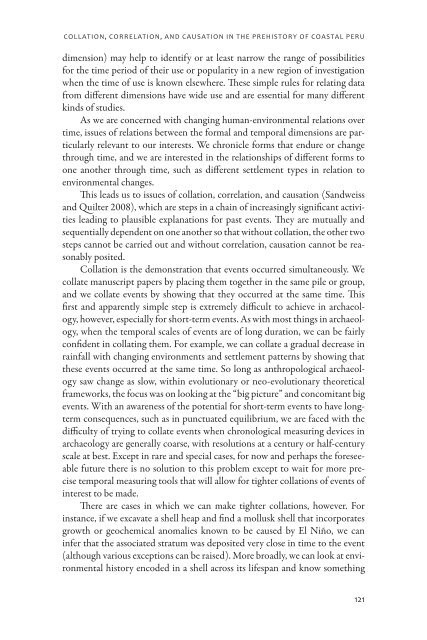free download - University Press of Colorado
free download - University Press of Colorado
free download - University Press of Colorado
You also want an ePaper? Increase the reach of your titles
YUMPU automatically turns print PDFs into web optimized ePapers that Google loves.
Collation, Correlation, and Causation in the Prehistory <strong>of</strong> Coastal Peru<br />
dimension) may help to identify or at least narrow the range <strong>of</strong> possibilities<br />
for the time period <strong>of</strong> their use or popularity in a new region <strong>of</strong> investigation<br />
when the time <strong>of</strong> use is known elsewhere. These simple rules for relating data<br />
from different dimensions have wide use and are essential for many different<br />
kinds <strong>of</strong> studies.<br />
As we are concerned with changing human-environmental relations over<br />
time, issues <strong>of</strong> relations between the formal and temporal dimensions are particularly<br />
relevant to our interests. We chronicle forms that endure or change<br />
through time, and we are interested in the relationships <strong>of</strong> different forms to<br />
one another through time, such as different settlement types in relation to<br />
environmental changes.<br />
This leads us to issues <strong>of</strong> collation, correlation, and causation (Sandweiss<br />
and Quilter 2008), which are steps in a chain <strong>of</strong> increasingly significant activities<br />
leading to plausible explanations for past events. They are mutually and<br />
sequentially dependent on one another so that without collation, the other two<br />
steps cannot be carried out and without correlation, causation cannot be reasonably<br />
posited.<br />
Collation is the demonstration that events occurred simultaneously. We<br />
collate manuscript papers by placing them together in the same pile or group,<br />
and we collate events by showing that they occurred at the same time. This<br />
first and apparently simple step is extremely difficult to achieve in archaeology,<br />
however, especially for short-term events. As with most things in archaeology,<br />
when the temporal scales <strong>of</strong> events are <strong>of</strong> long duration, we can be fairly<br />
confident in collating them. For example, we can collate a gradual decrease in<br />
rainfall with changing environments and settlement patterns by showing that<br />
these events occurred at the same time. So long as anthropological archaeology<br />
saw change as slow, within evolutionary or neo-evolutionary theoretical<br />
frameworks, the focus was on looking at the “big picture” and concomitant big<br />
events. With an awareness <strong>of</strong> the potential for short-term events to have longterm<br />
consequences, such as in punctuated equilibrium, we are faced with the<br />
difficulty <strong>of</strong> trying to collate events when chronological measuring devices in<br />
archaeology are generally coarse, with resolutions at a century or half- century<br />
scale at best. Except in rare and special cases, for now and perhaps the foreseeable<br />
future there is no solution to this problem except to wait for more precise<br />
temporal measuring tools that will allow for tighter collations <strong>of</strong> events <strong>of</strong><br />
interest to be made.<br />
There are cases in which we can make tighter collations, however. For<br />
instance, if we excavate a shell heap and find a mollusk shell that incorporates<br />
growth or geochemical anomalies known to be caused by El Niño, we can<br />
infer that the associated stratum was deposited very close in time to the event<br />
(although various exceptions can be raised). More broadly, we can look at environmental<br />
history encoded in a shell across its lifespan and know something<br />
121





